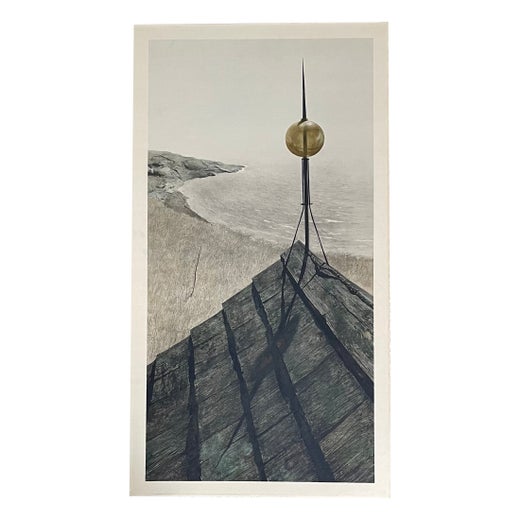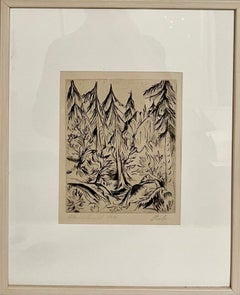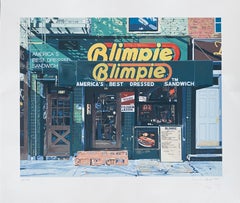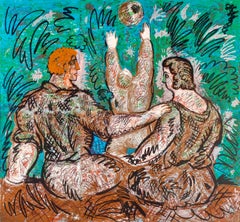Want more images or videos?
Request additional images or videos from the seller
1 of 12
Andrew WyethVintage Andrew Wyeth Abrams Art Print Americana Offset Lithograph from Holland1956
1956
Price:$500
$650List Price
About the Item
- Creator:Andrew Wyeth (1917-2009, American)
- Creation Year:1956
- Dimensions:Height: 26 in (66.04 cm)Width: 20 in (50.8 cm)
- Movement & Style:
- Period:
- Condition:never been framed. minor wear commensurate with age. please see photos.
- Gallery Location:Surfside, FL
- Reference Number:1stDibs: LU3824443201
Andrew Wyeth
An artist who pursued his own course when the rest of the art world was consumed with modernism and abstraction, Wyeth is considered among the preeminent representational painters of the 20th century. Born in Chadds Ford, Pennsylvania, Wyeth drew his subject matter from the world around him: the interiors and exteriors of the stone buildings, mills, and farms of the Brandywine River countryside, and in the summers, the clapboard houses and stark landscape of the Maine coast. After his father died in a 1945 automobile accident, Wyeth began to incorporate people into his pictures, most notably Christina Olson, and later Siri Erickson, of Cushing, Maine, and his Chadds Ford neighbors Karl and Anna Kuerner and Helga Testorf. The first visual artist to appear on the cover of Time magazine, Wyeth was also the first living American-born artist to be given an exhibition at The Metropolitan Museum of Art in New York. Wyeth’s naturalistic style is marked by strong editing combined with remarkable execution of details. While relying on keen visual observation, he pared down the elements of a composition to their most essential, giving his works an abstracted quality and imbuing them with a sense of quietude and stillness. The egg tempera medium (which he came to prefer to oil after first experimenting with it in the early 1940s) lent itself to the precise detailing required to create his subtle textural effects, since it dries quickly and translucent layers can be built up over one another. Wyeth also painted extensively in watercolor in works of more spontaneous execution, as well as in the drybrush technique (where most water is removed from the watercolor medium), sometimes combining the two.
About the Seller
4.9
Platinum Seller
Premium sellers with a 4.7+ rating and 24-hour response times
Established in 1995
1stDibs seller since 2014
1,810 sales on 1stDibs
Typical response time: 1 hour
Authenticity Guarantee
In the unlikely event there’s an issue with an item’s authenticity, contact us within 1 year for a full refund. DetailsMoney-Back Guarantee
If your item is not as described, is damaged in transit, or does not arrive, contact us within 7 days for a full refund. Details24-Hour Cancellation
You have a 24-hour grace period in which to reconsider your purchase, with no questions asked.Vetted Professional Sellers
Our world-class sellers must adhere to strict standards for service and quality, maintaining the integrity of our listings.Price-Match Guarantee
If you find that a seller listed the same item for a lower price elsewhere, we’ll match it.Trusted Global Delivery
Our best-in-class carrier network provides specialized shipping options worldwide, including custom delivery.You May Also Like
Hydrofoil, Photorealist Lithograph by Raymond Loewy
By Raymond Loewy
Located in Long Island City, NY
Artist: Raymond Loewy, American (1893 - 1986)
Title: Hydrofoil
Year: 1978
Medium: Lithograph, signed and numbered in pencil
Edition: 300
Image Size: 17 x 24 inches
Size: 21 in. x 28 ...
Category
1970s American Realist Figurative Prints
Materials
Lithograph
Original War Fund Week Keep this Hand of Mercy at its work vintage poster
Located in Spokane, WA
Original WW1 poster: Keep this Hand of Mercy at its work. War Fund Week. One hundred Million Dollars. Original WW1 lithograph, archival line...
Category
1910s American Realist Landscape Prints
Materials
Lithograph
$500 Sale Price
20% Off
H 27.25 in W 20.25 in D 0.05 in
Original Windsor, See Britain by Train vintage poster
By Gordon Nicoll
Located in Spokane, WA
Original Windsor See Britain by Train vintage railroad poster. Linen backed in very fine condition, ready to frame. No restoration to t...
Category
1950s American Realist Landscape Prints
Materials
Lithograph
$1,720 Sale Price
20% Off
H 39 in W 24 in D 0.05 in
Original For their future - Buy War Bond vintage World War 2 vintage poster
Located in Spokane, WA
Original WWII vintage poster: FOR THEIR FUTURE - BUY WAR BONDS.
Original vintage WWII poster by the artist Munsett, 1943. U. S. Government printing: 1943-0-513138. Archival l...
Category
1940s American Realist Figurative Prints
Materials
Offset
$471 Sale Price
20% Off
H 28 in W 22 in D 0.05 in
Original Historic Carlisle - Gateway to Scotland vintage railroad poster
Located in Spokane, WA
Original British vintage poster: Historic Carlisle - Gateway to Scotland. Artist: Maurice Greiffenhagen. Horizontal size 39" x 48.75". Archival linen-backed original stone lithograph; ready to frame. In very good to excellent condition.
Original, 1925 horizontal travel by train stone lithograph. Historic Carlisle ~ 800 years of Civic Independence. See Britain by train. British Railways. Published by British Railways (London Midland Region) LM 16657.
Probably the most famous British railway poster of the 1920s. The LMS commissioned designs from 16 leading Royal Academicians in 1924, of which this was by far the most popular.
A British Royal seal...
Category
1920s American Realist Figurative Prints
Materials
Lithograph
$2,760 Sale Price
20% Off
H 48.75 in W 39 in D 0.05 in
Original Chamonix Mont-Blanc vintage travel poster
Located in Spokane, WA
Original vintage travel poster Chamonix Mont-Blanc PLM French travel poster. Very good condition, archival linen backed. Ready to frame. ...
Category
1930s American Realist Landscape Prints
Materials
Lithograph
$8,500
H 39.38 in W 24.5 in D 0.07 in
Original earliest Rome via TWA vintage travel poster
By David Klein
Located in Spokane, WA
Original linen-backed vintage travel poster: ROME via TWA. TWA Trans World Airlines. Lockheed Constellation flying over the statue of Poseidon (Neptune) Statue, Piazza Navona, ...
Category
1950s American Realist Figurative Prints
Materials
Offset
$1,225
H 40 in W 25 in D 0.07 in
Original Australia, Australian Rules - VFL (AFL) vintage Football sports poster
Located in Spokane, WA
Original Australia Sports Poster – Vintage Australian Rules Football– Iconic AFL, archival linen-backed, very fine condition, ready to frame. Printed for the Australian Tourist Com...
Category
1960s American Realist Figurative Prints
Materials
Offset
$1,250
H 39.5 in W 24 in D 0.3 in
Original Learn to Make and Test Big Guns vintage World War 1 poster
Located in Spokane, WA
"Learn to Make and Test the Big Guns" original vintage poster: linen backed. Grade A condition. Ordnance recruiting poster No. 2.
Better yourself – Enlist and learn a Trade in the Ordnance Department U.S.A. Linen-backed, horizontal, fine condition. A rare original poster.
Aberdeen Proving Ground …. Daily peacetime firing. Publisher: Washington, D.C.: Engineer Reproduction Plant, U.S. Army, 1919. OCLC: 51040606
The recruiting and training of artillery units were crucial to American victory in World War I. For the Saint-Mihiel offensive, General Pershing...
Category
1910s American Realist Landscape Prints
Materials
Lithograph
$1,560 Sale Price
20% Off
H 19.25 in W 25 in D 0.05 in
Put Fighting Blood in Your Business
Located in Spokane, WA
Original WW1 poster. Put Fighting Blood in Your Business. Here’s his record! Does he get a Job? Arthur Woods, Assistant to the Secretary of...
Category
1910s American Realist Landscape Prints
Materials
Lithograph
More From This Seller
View All1920 German Expressionist Figurative Lithograph "The Forest" Paul Kleinschmidt
By Paul Kleinschmidt
Located in Surfside, FL
Paul Kleinschmidt, (1883–1949)
"The Forest"
Lithograph on Cream Paper
1920
Frame: 21" X 17"
Image: 10.75" X 8.5"
An expressionist forest scene with pine trees
Provenance: bears label...
Category
1920s Abstract Figurative Prints
Materials
Lithograph, Paper
1922 German Expressionist Figurative Train Tunnel Etching Paul Kleinschmidt
By Paul Kleinschmidt
Located in Surfside, FL
Paul Kleinschmidt, (1883–1949)
"Tunnel" Etching
1922
Frame: 17" X 21"
Image: 10.5" X 13.5"
Rare Artist's Proof edition 1 of 4
An architectural study of a bridge and train tunnel
Prov...
Category
1920s Abstract Figurative Prints
Materials
Paper, Etching
Blimpie, America's Best Dressed Sandwich Pop Art Photo Realist Silkscreen Litho
By Charles Ford
Located in Surfside, FL
Charles Ford, American Photo Realist Pop Artist Texas Artist
Photorealism is a movement which began in the late 1960's, in which scenes are painted in a style closely resembling phot...
Category
20th Century Photorealist Landscape Prints
Materials
Screen
Huge 6X6 Lithograph Italian Post Modernist Figurative Pop Art Children's Holiday
By Sandro Chia
Located in Surfside, FL
Sandro Chia (Italian, 1946)
Children Holiday, 1984
Lithograph in colors on six sheets of Somerset soft white,
71 x 77 inches (180.3 x 195.6 cm)
Numbered A.P. 13/15 (aside from an edi...
Category
1980s Pop Art Figurative Prints
Materials
Lithograph
Israeli Naive Art Screen Print Lithograph Jerusalem, Sanhedrin Old City Folk Art
By Gabriel Cohen
Located in Surfside, FL
Bold color lithograph, hand signed in pencil and numbered AP IX/X (artist’s proof 9/10), Jerusalem Print Workshop blind stamp lower right. On French Arches paper.
Gabriel Cohen, Sel...
Category
20th Century Folk Art Landscape Prints
Materials
Lithograph, Screen
1936 Lithograph Soldiers in battle World War I small edition
By George Grosz
Located in Surfside, FL
According to the frontis these were produced by Hand Lithography. According to the Museum of Modern Art (MOMA NY) website "Edition:300 announced; only approx. 42 issued (including r...
Category
1930s Landscape Prints
Materials
Lithograph
Recently Viewed
View AllMore Ways To Browse
Hog Oiler
David L Abel
David Shrigley Black Cats Everywhere
Degas Ballerina Etchings
Degas Signed Lithograph
Dieu Et Mon Droit
Distorted Face Paintings
Donna Evans
Earl Washington
Eduardo Paolozzi On Sale
Edward Borein Etching
Edward Millman
El Cid
Engravings Shakespeare
Ernie Barnes On Sale
Erte Autumn
Erte Four Seasons
Erte Letter D




